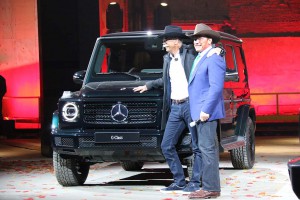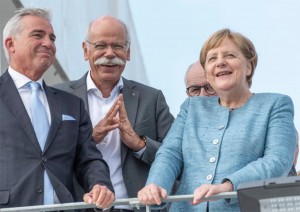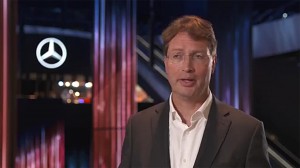
Daimler CEO Dieter Zetsche - shown at the 2018 Detroit Auto Show with Arnold Schwarzenegger after debuting the new G-Class SUV.
Dieter Zetsche, the CEO of Daimler AG, will be moving up, and a step closer to retirement next year when he assumes the job of chairman of the German manufacturer’s Supervisory Board.
Easily recognizable with his brush mustache, Zetsche will turn 66 as he hands day-to-day control over to Ola Kaellenius, currently the director of vehicle development for the Mercedes-Benz brand. A 49-year-old Swede, Kaellenius will become the first non-German to head the company since it was founded 132 years ago.
“In Ola Kaellenius, we are appointing a recognized, internationally experienced and successful Daimler executive,” said current Daimler Chairman Manfred Bischoff in a statement, adding that “With Dieter Zetsche’s intended appointment as Chairman of the Supervisory Board, we are ensuring continuity for the sustained success of Daimler AG.”
(Mercedes’ Project One hypercar comes closer to production. Click Here to catch it in track testing.)
The planned management transition, which still must win formal approval, comes at a critical time for the Stuttgart-based manufacturer. For one thing, Zetsche was steering Daimler towards a strategic shift that would split it into three distinct divisions. He has also been investing heavily in transformative technologies, including autonomous vehicles and electrified drivelines. The Mercedes brand is preparing to launch its first long-range all-electric model, the EQC, with an entire family of battery-cars to be marketed under the new Mercedes-EQ sub-brand. Daimler’s Smart brand will itself go all-electric.

Zetsche, center, fit in well in German society, regularly meeting with leaders like Chancellor Angela Merkel.
The company also faces a series of challenges, including ongoing investigations in both the U.S. and Europe where regulators want to know if Daimler rigged diesel engines to illegally pass emissions tests. That could trigger a scandal on a par with what German rival Volkswagen AG has experienced, VW so far paying out about $30 billion to settle the affair.
Daimler is also facing the challenge of negotiating the trade war that President Donald Trump has initiated. It issued a warning in June that profits could take a hit due to the tit-for-tat tariffs being enacted by the U.S. and China. Mercedes is one of the largest exporter of American-made automobiles, many of the SUVs produced at its plant in Alabama earmarked for China. Like BMW and Ford, it is coping with an expected decline in demand as those products now face 40% import tariffs, up from 25% before Trump set off the trade dispute.
The U.S. president has also warned he may put in place tariffs on vehicles imported from Europe, last Maytelling French President Emmanuel Macron that he wanted to stop Mercedes-Benz models from driving down Fifth Avenue in New York.
(Mercedes bringing at least four new models to upcoming Paris Motor Show. Click Here to check them out.)
For his part, Zetsche has proven adept at negotiating crises. Soon after the “merger of equals” between what was then Daimler-Benz with Detroit-based Chrysler Corp. in 1998, the executive was sent to the States to run the American side of the company. In an accented, but otherwise perfect, English, Zetsche quickly became the face of the company, nicknamed “Dr. Z.” in a running series of TV commercials in which he hailed the benefits of Chrysler products, signing off with the German, “auf wiedersehen.”

Ola Kaellenius, 49, earned a degree in finance and accounting University of St. Gallen in Switzerland and international management from the Stockholm School of Economics
Zetsche was subsequently called back to Stuttgart and, in 2006 replaced Juergen Schrempp, the architect of the deal, ultimately breaking up the trans-Atlantic partnership. Chrysler was effectively given to the New York-based investment giant Cerberus which then let it plunge into bankruptcy as the Great Recession caused the collapse of U.S. auto sales.
For its part, Zetsche helped Daimler largely sidestep the worst of that downturn, the automotive side of the company gaining ground worldwide. It has, however, faced some struggles maintaining its standing in China where the Mercedes brand has undergone a series of reorganizations and management shake-outs. But, since 2016, Mercedes has firmly established its sales lead in the global luxury car race.
Some of Zetsche’s biggest challenges have come from inside the company. More than a few analysts blamed a rigid corporate culture, tinged with Germanic arrogance, for the failure of the DaimlerChrysler merger. He confirmed to TheDetroitBureau.com on several occasions the difficulty of getting the two sides of the carmaker to work together to ensure Chrysler got the best technology from its partner.
In his push to reform Stuttgart-based operations, Zetsche frequently turned to Kaellenius, who had joined Daimler in 1993 as a trainee. They pushed to cut through the company’s notoriously dense bureaucracy and foster a culture more like what Kaellenius saw in Silicon Valley, encouraging lower-level employees to speak up when they had good ideas. Like the California tech center, Kaellenius wanted Daimler to become more comfortable taking risks and accepting failure – as long as the proper lessons could be learned.
That approach has helped Daimler to position itself at the forefront of some major changes expected to sweep through the auto industry over the coming decades. Its S-Class is considered to offer some of the most advanced, semi-autonomous technologies now on the road. The EQC will help position Mercedes to challenge EV leader Tesla. And the new MBUX infotainment system first introduced on the new Mercedes-Benz A-Class will bring Amazon Alexa-style voice assistant technology into the passenger compartment.
While Kaellenius has earned a solid reputation as the man overseeing many of these developments he will still face the challenge of being a Swede working within a German industry that retains a nationalistic streak, according to observers. He will also come in at a relatively young age, meaning he could spend nearly two decades in his new job.
There will be a number of other management changes coming next year. Markus Schaefer, who has led a high-tech transformation at Daimler’s factories as head of production, will replace Kaellenius as research chief. Wilko Stark, currently Daimler’s director of strategy and planning, will take over procurement and supplier quality. And digital tech boss Sajjad Khan, who oversaw the development of the MBUX project, will become the head of connected autonomous shared electric (CASE) and the Electric Vehicle Architecture (EVA) organization.
Shareholders will get a formal say on the new management team during their annual meeting next May.
(Debut of EQC launches Mercedes into long-range, all-electric market. To check it out, Click Here.)

